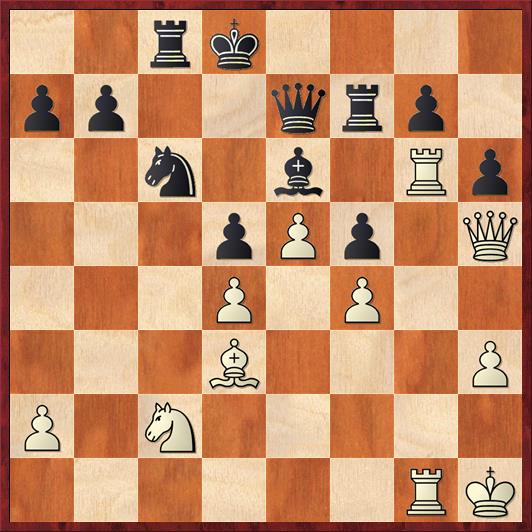This weekend we had an abrupt change in the weather in Santa Cruz. After zero inches of rain so far this fall, the heavens opened and we had three straight days of downpour. The only thing to do was stay inside and play chess, so Gjon Feinstein and I met up with Eric Montany. Actually Eric couldn’t stay long because he has a two-month-old baby at home. (Congratulations, Eric! Did you see how I worked that into this post?) But Gjon and I played several speed games, most of which I lost, as usual. The last one ended in a very interesting position.

FEN: 2rk4/pp2qrp1/2n1b1Rp/3pPp1Q/3P1P2/3B3P/P1N5/6RK w – – 0 27
I was White in a French Defense, and here my flag fell. It’s a real shame because the battle is just getting started. What do you think White should play? And how do you evaluate the position?
Gjon and I analyzed the position after the game, and later I came home and put it on my computer. I have to say that we got the first move right and everything else wrong. So be very careful and make sure that your analysis is correct.
It’s hard to see any way that White can improve his position any more with “slow” moves. All of the pieces except the knight are basically in their best possible locations. The knight would like to go to e3, but unfortunately 27. Ne3 would be met by 27. … Nxd4. Black’s king is in the middle of the board, so White would like to strike now, before the king can run to the queenside.
All signs, therefore, point toward the immediate exchange sacrifice: 27. Rxe6! If you figured that out, congratulations! You got the first part of the quiz right!
After the forced 27. … Qxe6 28. Rg6, Black’s can play either 28. … Qe8 or 28, … Qe7. The latter move gives White an extra tempo to play 29. Rd6+ Kc7 30. Ne3, when 30. … Nxd4?? now runs into 31. Nxd5+ forking the king and queen.
So 27. Rxe6! Qxe6 28. Rg6 Qe8 seems best, and then 29. Bxf5 is the most natural move, basically forcing Black to give back the exchange. In our postmortem it looked absolutely decisive. But not according to the computer! It finds the cold-blooded defense 29. … Qf8! 30. Bxc8 Kxc8 and White cannot stop Black’s invasion on the f-file. Rybka gives 31. Qg4+ Kb8 32. Ne3 Rxf4 33. Qd7 when 33. … Rf1+!! saves a draw by perpetual check.
Naturally, Gjon and I did not see the computer move 29. … Qf8! (let alone the saving move 33. … Rf1+!!). The natural “human” defense, which most likely would have happened in the game, is 29. … Rxf5, after which 30. Qxf5 Ne7 31. Rd6+ Kc7 32. Qe6 is all basically forced. Now there are several possibilities for Black: 32. … Qh5, 32. … Qb5, and 32. … Kb8, but they are all met by the same strong move for White: 33. Ne3! In all variations this defensive move holds off Black’s counterattack just long enough for White to win, although it takes a computer’s precision to be confident of this statement.
For example, I would consider the “main line” (or at least the most thematic line) to be 27. Rxe6! Qxe6 28. Rg6 Qe8 29. Bxf5 Rxf5? 30. Qxf5 Ne7 31. Rd6+ Kc7 32. Qe6 Qh5 33. Ne3! Qf3+ 34. Ng2 Kb8, when either 35. Kh2 (the insanely wonderful computer move) or 35. Rd7 (the normal human move) seem to be winning.
Note that White does not want to take the knight because 35. Qxe7?? Qxh3+ 36. Kg1 Rc1+ would win for Black. By playing Rybka’s prophylactic move 35. Kh2! White ensures both that the h3 pawn is defended and that Black will not be able to move his rook with check. For instance, 35. … Rc2 36. Rd8+ Nc8 37. Qg4! Qxg4 38. hg Rxa2 39. f5. Even though Black is a pawn up, White’s pawns are much faster.
Although I would never in a million years have played this way, there is something deeply satisfying in seeing how the computer combines attack and defense with moves like 33. Ne3!, 35. Kh2! and 37. Qg4.
The only move I can definitely say that I would have played (if my flag had not fallen) is the initial sacrifice, 27. Rxe6! In a game between humans, rather than computers, you sometimes have to go with gut feelings rather than 10-move-deep analysis. My analysis would boil down to three simple words: “Now or never.”



{ 1 trackback }